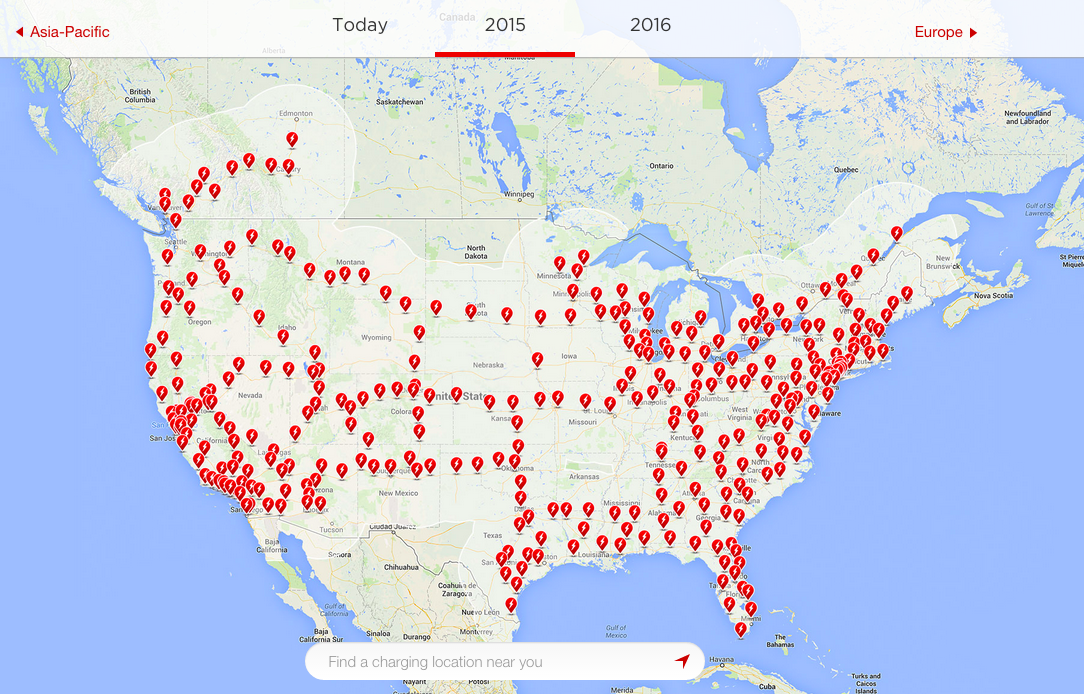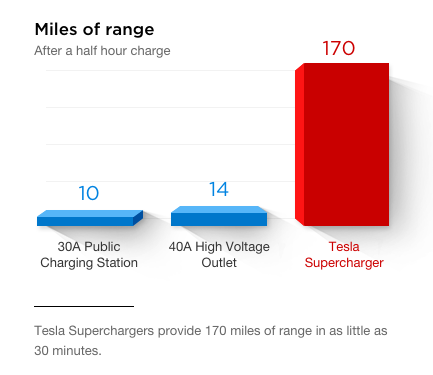One of the main advantages of the Tesla Model S is its relative freedom from “range anxiety,” at least in the 85-kilowatt-hour battery pack of the higher-end versions.
Rated by the U.S. Environmental Protection Agency at 265 miles, that range compares to ratings of 62 to about 90 miles in less expensive plug-in electric cars.
And the Model S vehicles offer even greater freedom for road trips via the global network of proprietary Supercharger systems funded and built entirely by Tesla Motors for its owners.
For early Tesla Model S85 owners, the first groups of these Supercharger sites were clustered around the company’s factory in Fremont, California. Tesla got its first and strongest foothold in California, and one of the first six Supercharger sites was at the Folsom Outlet Mall — a placement that allowed Bay Area Tesla drivers to get to the ski vacation and gambling haunts of Lake Tahoe and Reno.
Each Supercharger site has six or more charging connectors, and is advertised as providing “up to 170 miles of added range in 30 minutes.”
The caveat, of course, is the “up to,” as I’ve never seen more than 140 miles in half an hour with my 2013 Tesla Model S. But that 170-mile figure was usually achieved in 45 minutes, and I’ve Supercharged more than 30 times now.
Often on major trips, I’d stay long enough to top off the battery for a full-range charge (272 miles in my S85).
Free use (as long as you own your Tesla)
One of the great things about owning a Tesla is that use of the Supercharger network is free forever. That makes the growing network of sites a major part of Tesla’s ability to provide an electric car that can serve as a household’s only vehicle for all driving needs.
That’s true across the world, as Tesla says it now has 396 Supercharger stations globally, with more than 2,150 individual chargers.
For Tesla’s main market, the United States, the growth of these charging stations has been quite dramatic over the past 12 to 18 months.
And the growth continues, to the point where this article had to be updated twice over the few days it was being edited.
From January through April last year, Tesla opened 39 Supercharger sites with a total of 104 charging points. Then from May through August, it added another 20 sites with 122 charging cables. The pace ramped up from there, with another 37 sites with 265 total charging points being added from September through December.
And through this weekend, 29 more were opened with more than 180 additional cables.
Despite some early missed deadlines for getting Supercharger sites up and running, it seems clear that Tesla is following through on its promise to offer a national network of Superchargers.
More accurately, it’s now a North American network: Canada too has seen the installation of 12 charging stations with a total of 62 chargers during this same time period.
And many more are permitted or under construction throughout the United States and Canada.
For the latest details on Supercharger sites, the Teslarati fan site maintains a summary of Tesla charging stations.
The same information can also be found on Tesla’s own site.
This story originally appeared on Green Car Reports. Copyright 2015
VentureBeat's mission is to be a digital town square for technical decision-makers to gain knowledge about transformative enterprise technology and transact. Learn More



